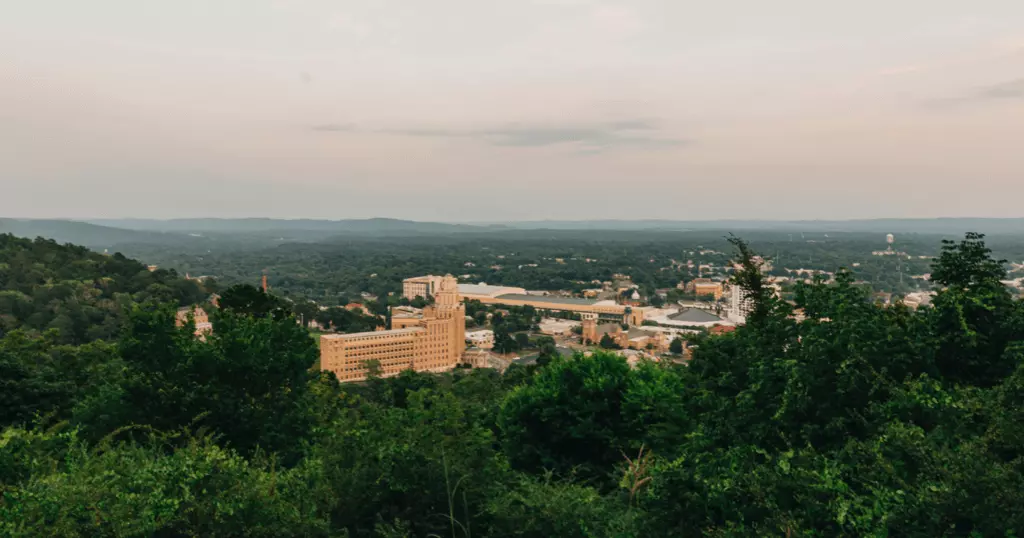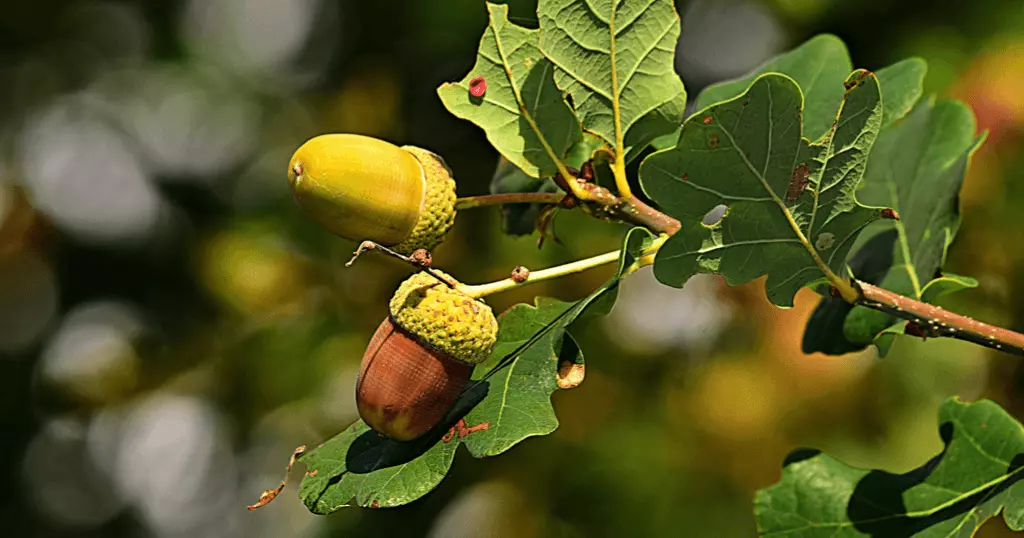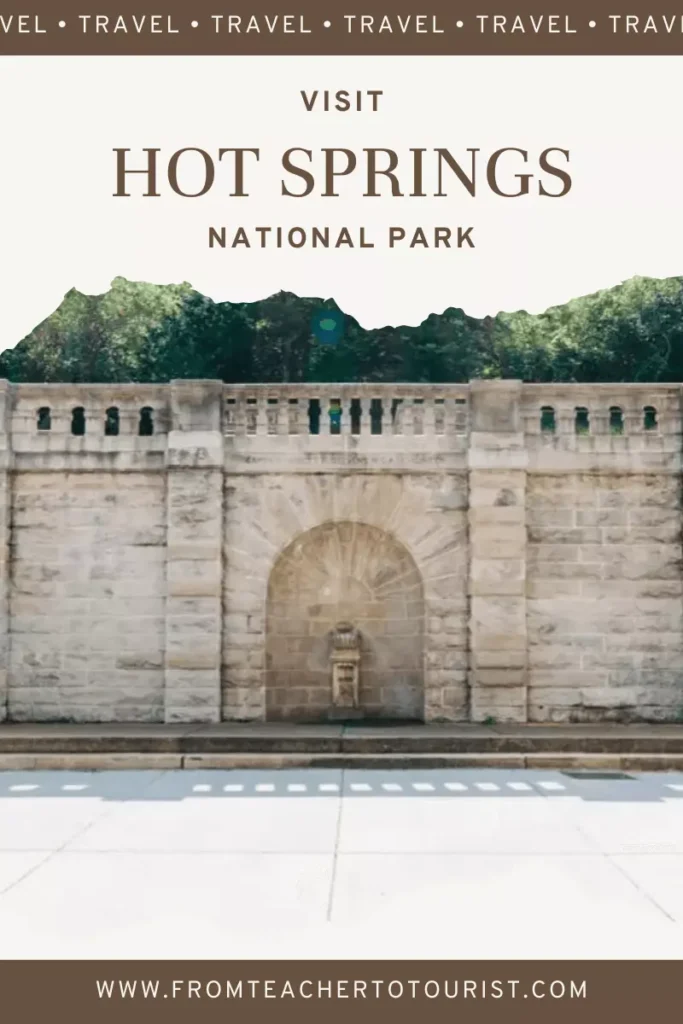Last updated on July 29th, 2023 at 11:18 pm
Located in the heart of Arkansas, Hot Springs National Park beckons travelers to embark on a remarkable journey where the healing powers of natural hot springs intermingle with awe-inspiring landscapes. Spanning approximately 5,500 acres, this national park seamlessly blends a rich history, diverse wildlife, and rejuvenating thermal waters, creating an unparalleled experience for those seeking relaxation, exploration, and a profound connection with nature.

Discovering the Wilderness:
Hot Springs National Park’s allure lies in its captivating blend of urban and natural landscapes. Set amidst the enchanting Ouachita Mountains, the park boasts rugged terrains, dense forests, and picturesque valleys. The mesmerizing hot springs that lend their name to the park emerge from the western slope of Hot Springs Mountain, creating a truly awe-inspiring spectacle.
Within the park’s diverse ecosystem, a myriad of plant species flourish. Delicate wildflowers add vibrant pops of color to the landscape, while towering pines exude a sense of grandeur. Venture deeper into the trails, and you’ll discover lush ferns, ancient oaks, and an assortment of flora that grace this sanctuary. Wildlife enthusiasts will delight in encountering native species such as white-tailed deer, black bears, foxes, bobcats, and an array of bird species that call this park home.
Must-See Points of Interest:

- Bathhouse Row: The crown jewel of Hot Springs National Park, Bathhouse Row, stands as a testament to the city’s rich history. Comprising eight iconic bathhouses along Central Avenue, these architectural marvels transport visitors to a bygone era. While some have been repurposed into visitor centers and museums, the aura of the past remains palpable.
- Hot Springs Mountain Tower: Ascend the 216-foot tower for a breathtaking panorama of the surrounding landscapes. From this vantage point, the splendor of the Ouachita Mountains unfolds, stretching as far as the eye can see. Witness the majesty of the park from above and gain a newfound appreciation for its unparalleled beauty.
- Grand Promenade: Meandering along the historic hot springs, the Grand Promenade offers a serene pathway flanked by towering trees. Immerse yourself in the therapeutic energy of the thermal waters as you take a leisurely stroll, soaking up the tranquil ambiance and marveling at the grandeur of the bathhouses that line this enchanting promenade.
- Gulpha Gorge Campground: Tucked away in a secluded valley, the Gulpha Gorge Campground provides an idyllic setting for nature enthusiasts. Set up camp amidst nature’s embrace, unwind beside the soothing creek, and relish in the serenity that envelops you.
Practical Information for Visitors:
- Location: Hot Springs National Park is situated in central Arkansas, approximately 50 miles southwest of Little Rock, making it easily accessible for visitors from various locations.
- Operating Hours: The park welcomes visitors year-round, with operating hours for visitor centers and attractions varying. The Fordyce Bathhouse Visitor Center is open daily from 9:00 AM to 5:00 PM. For up-to-date information on other facilities, consult the official park website or contact the park directly.
- Entrance Fees: Entry to Hot Springs National Park is free, allowing visitors to explore and enjoy its wonders without a fee. However, certain activities, such as bathing and spa treatments, may incur charges.
- Best Time to Visit: Hot Springs National Park offers captivating experiences throughout the year, each season providing its own unique charm. Spring and fall offer pleasant temperatures, ideal for engaging in outdoor activities and soaking in the park’s natural beauty. Summers can be hot and humid, while winters are mild, occasionally dusted with snowfall, adding a touch of enchantment to the park’s landscapes.
- Accommodation: Hot Springs and its surrounding areas offer a wide range of accommodation options, from luxury resorts and cozy bed and breakfasts to budget-friendly hotels and cabins. Whether you prefer to stay within the city or immerse yourself in nature’s embrace, you’ll find lodging choices to suit every preference.
Outdoor Recreation Opportunities:
Hot Springs National Park caters to a variety of outdoor activities, ensuring there’s something for everyone:
- Hiking: Traverse the park’s extensive trail system, which offers options suitable for all skill levels. Whether you seek a leisurely nature walk or a challenging summit hike, the trails deliver memorable experiences. Embark on the 10-mile Sunset Trail, rewarding hikers with awe-inspiring vistas along its scenic route. For a shorter yet equally captivating hike, explore the Hot Springs Mountain Trail, immersing yourself in the park’s natural beauty.
- Hot Springs Thermal Area: Immerse yourself in the therapeutic bliss of the historic Buckstaff Baths or Quapaw Baths & Spa, both situated on Bathhouse Row. Surrender to the natural wonders of the thermal waters as their healing properties wash away stress and rejuvenate your body and spirit. Indulge in spa treatments, mineral baths, and a range of wellness therapies that have drawn visitors seeking relaxation and healing for centuries.
- Bird Watching: Grab your binoculars and revel in the abundant birdlife that graces Hot Springs National Park. Join a guided birding tour to enhance your experience or venture out independently. With over 250 species spotted throughout the year, this sanctuary serves as a haven for birdwatching enthusiasts. Keep an eye out for the vibrant Eastern bluebird, the elusive prothonotary warbler, and the majestic bald eagle, among others.
- Fishing: Cast your line into the park’s serene lakes and streams, such as Lake Hamilton, Lake Ouachita, and Gulpha Creek. Engage in a tranquil fishing experience, with ample opportunities to catch bass, catfish, crappie, and trout. Whether you’re an avid angler or a novice seeking a peaceful day by the water, Hot Springs National Park offers a serene fishing haven.
Exploring the Cultural Heritage:

Hot Springs National Park proudly embraces its rich cultural heritage:
- Fordyce Bathhouse Visitor Center: Step back in time as you enter the meticulously restored Fordyce Bathhouse. Delve into the park’s captivating history, learn about the therapeutic thermal waters, and gain insights into the spa culture that thrived in the early 20th century. Marvel at the opulent architecture, period furnishings, and interactive exhibits that bring the past to life.
- Historic Downtown Hot Springs: Just beyond the park’s boundaries lies the vibrant downtown area, brimming with historic charm. Traverse the streets lined with quaint boutiques, art galleries, and local eateries, immersing yourself in the city’s storied past. Explore Bathhouse Row’s unique shops, savor delicious Southern cuisine, or take a leisurely stroll along Central Avenue, savoring the delightful blend of history and contemporary allure.
- Gangster Museum of America: Discover a captivating chapter in Hot Springs’ history at the Gangster Museum of America. Uncover the city’s notorious past as a popular hideaway for infamous gangsters during the Prohibition era. Engaging exhibits, intriguing artifacts, and interactive displays provide a glimpse into the criminal underworld of the time.
Flora and Fauna:
Hot Springs National Park is not only a haven for therapeutic thermal waters and breathtaking landscapes but also home to a rich array of flora and fauna. The park’s diverse ecosystems support a tapestry of biodiversity, creating habitats for a wide range of plant and animal species.
Flora:

Within the park’s boundaries, an abundance of plant life flourishes, offering a captivating display of colors, textures, and scents. The varied terrain and diverse microclimates give rise to an impressive array of flora that adds to the park’s natural beauty.
The forested areas of Hot Springs National Park are characterized by a mix of deciduous and evergreen trees. Towering pines, including shortleaf pine and loblolly pine, dominate the landscape, their lush green crowns providing shelter for a multitude of wildlife. Oak species such as post oak, white oak, and southern red oak are also prevalent, contributing to the forest’s rich biodiversity.
The understory of the park is adorned with a diverse assortment of shrubs and wildflowers. Delicate wildflowers dot the landscape, offering bursts of color throughout the seasons. Visitors may encounter vibrant purple coneflowers, golden black-eyed Susans, delicate pink wild roses, and the enchanting blooms of cardinal flower and trillium. Ferns, such as maidenhair fern and cinnamon fern, add a touch of elegance to the forest floor, thriving in the moist and shaded areas near the thermal springs.
Along the park’s waterways and in wetland areas, aquatic plants flourish. Water lilies, pickerelweed, and various species of rushes and sedges create lush habitats that support an array of aquatic organisms. These wetland ecosystems are not only visually striking but also play a crucial role in maintaining the park’s ecological balance.
Fauna:

Hot Springs National Park is teeming with wildlife, offering a glimpse into the natural diversity of the region. From elusive mammals to colorful birds and fascinating reptiles, the park is home to a wide range of animal species.
White-tailed deer are commonly spotted throughout the park, gracefully navigating the forested areas. These gentle creatures, with their characteristic white tails, add an element of beauty and serenity to the park’s landscapes. Visitors may also catch a glimpse of smaller mammals such as foxes, raccoons, and bobcats, though these elusive creatures are more challenging to encounter.
The avian population in Hot Springs National Park is diverse and vibrant. Birdwatchers will be delighted by the variety of species that call this park home. Songbirds, including warblers, thrushes, and finches, fill the air with their melodious tunes. Woodpeckers, such as the vividly colored northern flicker and pileated woodpecker, can be seen and heard as they tap on tree trunks in search of insects. Raptors, including red-tailed hawks and barred owls, grace the skies, showcasing their aerial prowess.
In the park’s wetland areas, visitors may observe a variety of water-dwelling creatures. Turtles, such as the colorful painted turtle and the impressive snapping turtle, bask in the sun along the banks of lakes and ponds. Fish species, including bass, catfish, and various sunfish, populate the park’s waterways, providing opportunities for anglers to cast their lines and enjoy a day of fishing.
Hot Springs National Park is also home to a diverse array of reptiles and amphibians. Look closely, and you might spot a harmless garter snake or a vibrant Eastern box turtle. Frogs and toads serenade visitors with their melodic choruses during the warmer months, adding to the park’s auditory tapestry.
The park’s delicate ecosystems support not only larger and more visible creatures but also an array of insects, including butterflies, dragonflies, and bees. These small but vital organisms contribute to the park’s intricate food webs and pollination processes, playing a crucial role in maintaining the balance of the park’s ecosystems.
Exploring Hot Springs National Park provides opportunities to observe and appreciate the diverse flora and fauna that thrive within its borders. Whether catching a glimpse of a grazing deer, spotting a colorful bird perched on a tree branch, or admiring the intricate beauty of a wildflower, visitors are immersed in the rich tapestry of life that makes this park a truly special place.
Conservation and Sustainability Efforts:
Hot Springs National Park remains committed to preserving its natural and cultural resources:
- Water Quality and Conservation: Vigilantly monitoring the quality and flow of the hot springs’ thermal waters, the park ensures the sustainability of this precious resource for future generations. Efforts are made to maintain water quality standards, prevent contamination, and preserve the natural balance of the hot springs’ delicate ecosystem.
- Environmental Stewardship: Hot Springs National Park actively promotes environmental stewardship through various initiatives. These include waste reduction and recycling programs, energy-efficient practices, and the restoration and preservation of natural habitats. The park encourages visitors to follow Leave No Trace principles, minimizing their impact on the environment and respecting the park’s fragile ecosystems.
- Education and Outreach: The park’s interpretive programs and educational initiatives aim to raise awareness about the importance of conservation and sustainable practices. Visitors can participate in guided nature walks, talks, and workshops that delve into the park’s natural and cultural heritage, fostering a deeper understanding and appreciation for the need to protect and preserve these valuable resources.
FAQ About Hot Springs National Park

Is Hot Springs National Park worth it?
Absolutely, a visit to Hot Springs National Park is undeniably worth it. This remarkable Arkansas national park offers a blend of captivating natural beauty, rich cultural heritage, and unique experiences that leave a lasting impression. The therapeutic thermal waters, picturesque landscapes, and historic Bathhouse Row provide a one-of-a-kind backdrop for relaxation and rejuvenation. The diverse trails cater to outdoor enthusiasts, offering opportunities for scenic hikes and wildlife encounters. The park’s immersive historical sites, such as the Fordyce Bathhouse Visitor Center, take visitors on a journey through time. Additionally, the surrounding area boasts charming downtown streets, art galleries, and delectable cuisine. Whether seeking tranquility, adventure, or a deeper connection with nature and history, Hot Springs National Park delivers an enriching and worthwhile experience for all who venture into its embrace.
Can you swim in the hot springs at Hot Springs National Park?
Swimming directly in the hot springs at Hot Springs National Park is not permitted. The thermal waters that flow through the park are preserved for other uses, such as spa treatments and bathing facilities. The park’s guidelines prioritize the preservation of the thermal springs’ unique properties and protect them from contamination. While swimming in the hot springs themselves is not allowed, visitors can still enjoy water-based activities in designated areas or nearby lakes and streams. The park offers alternative options, such as the thermal pools at Quapaw Baths & Spa, where visitors can experience the rejuvenating effects of the hot springs in a controlled and therapeutic environment. It’s important to respect the park’s regulations and seek out approved locations and activities to enjoy water-related experiences during your visit.
What are the benefits of hot springs?
Hot springs offer a range of potential benefits for both physical and mental well-being. The mineral-rich waters found in hot springs are believed to have therapeutic properties that can promote relaxation, relieve muscle tension, and alleviate various ailments. The heat from the water helps to increase blood circulation, which may aid in the healing process of injuries or sore muscles. The minerals present in hot springs, such as magnesium, sulfur, and calcium, are thought to have skin-nourishing properties, potentially benefiting conditions such as eczema or psoriasis. Additionally, the serene environment and tranquil ambiance of hot springs can provide a much-needed respite from the stresses of daily life, promoting mental relaxation, stress reduction, and overall rejuvenation. Whether it’s physical healing, skin health, or mental relaxation, the benefits of hot springs extend beyond their soothing warmth, creating a holistic experience for those seeking therapeutic and rejuvenating effects.
Who should not go in a hot spring?
While hot springs can be a wonderful experience for many, there are certain individuals who should exercise caution or avoid immersing themselves in hot springs altogether. Pregnant women are advised to consult with their healthcare provider before entering hot springs due to the potential risks associated with high water temperatures and overheating. Individuals with cardiovascular conditions, high blood pressure, or a history of fainting should also be cautious as the hot water can increase heart rate and blood pressure. Those with open wounds or infections should refrain from entering hot springs to avoid potential contamination. Additionally, individuals who are sensitive or allergic to minerals found in hot springs should avoid prolonged contact with the water to prevent skin irritations. As with any activity, it is important to listen to your body and consult with a healthcare professional if you have any concerns or underlying medical conditions before immersing yourself in hot springs.
How hot is the water in Hot Springs National Park?
The water in Hot Springs National Park emerges from the earth at an average temperature of 143°F (62°C). These thermal waters have been naturally heated deep within the Earth’s crust and then rise to the surface through the hot springs. While the water temperature can vary slightly among the different springs in the park, the general range typically falls between 120°F to 150°F (49°C to 66°C). The high temperatures of the water make it unsuitable for direct swimming; however, they contribute to the therapeutic properties and allure of the hot springs, providing a soothing and relaxing experience for visitors who partake in spa treatments or bathe in the designated thermal pools. It’s important to note that the park’s regulations prioritize the preservation and safety of the hot springs, ensuring their availability for future generations to enjoy.
Do you need a swimsuit for hot springs?
Yes, if you plan to engage in spa treatments, visit bathhouses, or enjoy the thermal pools at Quapaw Baths & Spa, it is recommended to bring a swimsuit. While swimming in the hot springs themselves is not allowed, there are opportunities to soak in the thermal waters in designated areas or experience spa treatments that involve water immersion. Wearing a swimsuit will ensure your comfort and allow you to fully enjoy these activities. Additionally, if you plan to engage in water-based activities outside of the park, such as swimming in nearby lakes, having a swimsuit on hand will be beneficial. It’s always a good idea to check with specific establishments or facilities for any dress code requirements or recommendations.
Should you shower after swimming in hot springs?
While it is not mandatory to shower after swimming in hot springs, it is generally recommended for hygiene purposes. Hot springs often contain natural minerals and trace elements, and some individuals may prefer to rinse off any residue or impurities from their skin after immersing themselves in the water. Additionally, showering can help to regulate body temperature and remove any sweat or sunscreen that may have accumulated during the visit. It is important to note that each individual’s preference and comfort level may vary, so it is ultimately a personal choice. If shower facilities are available nearby, taking a quick shower can leave you feeling refreshed and ready for the next part of your day.
Final Thoughts:
Hot Springs National Park stands as an inviting sanctuary, where the convergence of nature’s therapeutic wonders and awe-inspiring landscapes creates an experience unlike any other. Whether you seek respite and relaxation, exhilarating outdoor adventures, or a profound connection with history and culture, this national park offers an all-encompassing journey. Embark on an exploration of Hot Springs National Park and allow yourself to be embraced by its restorative thermal waters and captivating landscapes. Surrender to the enchantment and discover a world where nature’s gifts intertwine harmoniously with human heritage. Immerse yourself in the healing embrace of the park’s hot springs, embark on scenic hikes through diverse ecosystems, and uncover the rich cultural tapestry of this remarkable destination. Hot Springs National Park invites you to discover the harmonious convergence of natural wonders and human history, leaving you with cherished memories and a deep appreciation for the power of nature’s therapeutic oasis.

